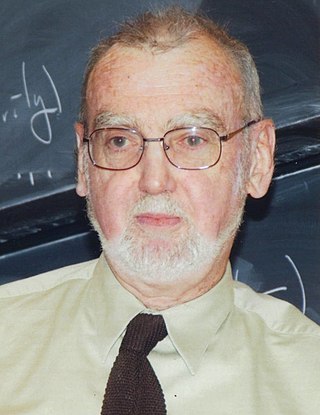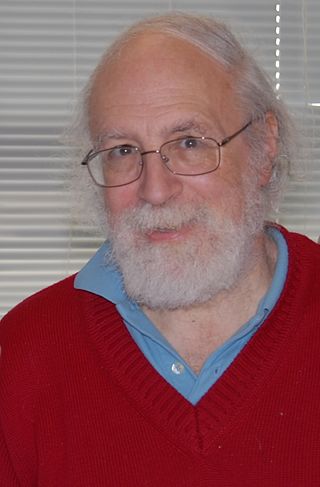Related Research Articles

Robert Phelan Langlands, is a Canadian mathematician. He is best known as the founder of the Langlands program, a vast web of conjectures and results connecting representation theory and automorphic forms to the study of Galois groups in number theory, for which he received the 2018 Abel Prize. He was an emeritus professor and occupied Albert Einstein's office at the Institute for Advanced Study in Princeton, until 2020 when he retired.
In representation theory and algebraic number theory, the Langlands program is a web of far-reaching and consequential conjectures about connections between number theory and geometry. Proposed by Robert Langlands, it seeks to relate Galois groups in algebraic number theory to automorphic forms and representation theory of algebraic groups over local fields and adeles. Widely seen as the single biggest project in modern mathematical research, the Langlands program has been described by Edward Frenkel as "a kind of grand unified theory of mathematics."
In mathematics, the Ramanujan conjecture, due to Srinivasa Ramanujan (1916, p. 176), states that Ramanujan's tau function given by the Fourier coefficients τ(n) of the cusp form Δ(z) of weight 12
In mathematics, an Artin L-function is a type of Dirichlet series associated to a linear representation ρ of a Galois group G. These functions were introduced in 1923 by Emil Artin, in connection with his research into class field theory. Their fundamental properties, in particular the Artin conjecture described below, have turned out to be resistant to easy proof. One of the aims of proposed non-abelian class field theory is to incorporate the complex-analytic nature of Artin L-functions into a larger framework, such as is provided by automorphic forms and the Langlands program. So far, only a small part of such a theory has been put on a firm basis.
In mathematics, the theta correspondence or Howe correspondence is a mathematical relation between representations of two groups of a reductive dual pair. The local theta correspondence relates irreducible admissible representations over a local field, while the global theta correspondence relates irreducible automorphic representations over a global field.
In mathematics, a Weil group, introduced by Weil (1951), is a modification of the absolute Galois group of a local or global field, used in class field theory. For such a field F, its Weil group is generally denoted WF. There also exists "finite level" modifications of the Galois groups: if E/F is a finite extension, then the relative Weil group of E/F is WE/F = WF/W c
E .
In representation theory, a branch of mathematics, the Langlands dualLG of a reductive algebraic group G is a group that controls the representation theory of G. If G is defined over a field k, then LG is an extension of the absolute Galois group of k by a complex Lie group. There is also a variation called the Weil form of the L-group, where the Galois group is replaced by a Weil group. Here, the letter L in the name also indicates the connection with the theory of L-functions, particularly the automorphic L-functions. The Langlands dual was introduced by Langlands (1967) in a letter to A. Weil.
In mathematics, the local Langlands conjectures, introduced by Robert Langlands, are part of the Langlands program. They describe a correspondence between the complex representations of a reductive algebraic group G over a local field F, and representations of the Langlands group of F into the L-group of G. This correspondence is not a bijection in general. The conjectures can be thought of as a generalization of local class field theory from abelian Galois groups to non-abelian Galois groups.
In number theory, a Shimura variety is a higher-dimensional analogue of a modular curve that arises as a quotient variety of a Hermitian symmetric space by a congruence subgroup of a reductive algebraic group defined over Q. Shimura varieties are not algebraic varieties but are families of algebraic varieties. Shimura curves are the one-dimensional Shimura varieties. Hilbert modular surfaces and Siegel modular varieties are among the best known classes of Shimura varieties.
In mathematics, the Arthur–Selberg trace formula is a generalization of the Selberg trace formula from the group SL2 to arbitrary reductive groups over global fields, developed by James Arthur in a long series of papers from 1974 to 2003. It describes the character of the representation of G(A) on the discrete part L2
0(G(F)\G(A)) of L2(G(F)\G(A)) in terms of geometric data, where G is a reductive algebraic group defined over a global field F and A is the ring of adeles of F.
In mathematics, endoscopic groups of reductive algebraic groups were introduced by Robert Langlands in his work on the stable trace formula.
In mathematics, the Jacquet–Langlands correspondence is a correspondence between automorphic forms on GL2 and its twisted forms, proved by Jacquet and Langlands (1970, section 16) in their book Automorphic Forms on GL(2) using the Selberg trace formula. It was one of the first examples of the Langlands philosophy that maps between L-groups should induce maps between automorphic representations. There are generalized versions of the Jacquet–Langlands correspondence relating automorphic representations of GLr(D) and GLdr(F), where D is a division algebra of degree d2 over the local or global field F.
In mathematics, the Kirillov model, studied by Kirillov (1963), is a realization of a representation of GL2 over a local field on a space of functions on the local field.
In the mathematical theory of automorphic forms, the fundamental lemma relates orbital integrals on a reductive group over a local field to stable orbital integrals on its endoscopic groups. It was conjectured by Robert Langlands (1983) in the course of developing the Langlands program. The fundamental lemma was proved by Gérard Laumon and Ngô Bảo Châu in the case of unitary groups and then by Ngô (2010) for general reductive groups, building on a series of important reductions made by Jean-Loup Waldspurger to the case of Lie algebras. Time magazine placed Ngô's proof on the list of the "Top 10 scientific discoveries of 2009". In 2010, Ngô was awarded the Fields Medal for this proof.
In mathematics, the Langlands–Shahidi method provides the means to define automorphic L-functions in many cases that arise with connected reductive groups over a number field. This includes Rankin–Selberg products for cuspidal automorphic representations of general linear groups. The method develops the theory of the local coefficient, which links to the global theory via Eisenstein series. The resulting L-functions satisfy a number of analytic properties, including an important functional equation.
In mathematics, Lafforgue's theorem, due to Laurent Lafforgue, completes the Langlands program for general linear groups over algebraic function fields, by giving a correspondence between automorphic forms on these groups and representations of Galois groups.
In mathematics, an automorphic L-function is a function L(s,π,r) of a complex variable s, associated to an automorphic representation π of a reductive group G over a global field and a finite-dimensional complex representation r of the Langlands dual group LG of G, generalizing the Dirichlet L-series of a Dirichlet character and the Mellin transform of a modular form. They were introduced by Langlands (1967, 1970, 1971).
Colette Moeglin is a French mathematician, working in the field of automorphic forms, a topic at the intersection of number theory and representation theory.

Stephen James Rallis was an American mathematician who worked on group representations, automorphic forms, the Siegel–Weil formula, and Langlands L-functions.
In mathematics, the Gan–Gross–Prasad conjecture is a restriction problem in the representation theory of real or p-adic Lie groups posed by Gan Wee Teck, Benedict Gross, and Dipendra Prasad. The problem originated from a conjecture of Gross and Prasad for special orthogonal groups but was later generalized to include all four classical groups. In the cases considered, it is known that the multiplicity of the restrictions is at most one and the conjecture describes when the multiplicity is precisely one.
References
- Arthur, James (2002), "A note on the automorphic Langlands group" (PDF), Canadian Mathematical Bulletin , 45 (4): 466–482, doi: 10.4153/CMB-2002-049-1 , MR 1941222
- Kottwitz, Robert (1984), "Stable trace formula: cuspidal tempered terms", Duke Mathematical Journal, 51 (3): 611–650, CiteSeerX 10.1.1.463.719 , doi:10.1215/S0012-7094-84-05129-9, MR 0757954
- Langlands, R. P. (1979-06-30), "Automorphic representations, Shimura varieties, and motives. Ein Märchen", Automorphic forms, representations and L-functions, Proc. Sympos. Pure Math., vol. 33, pp. 205–246, ISBN 978-0-8218-1437-6, MR 0546619